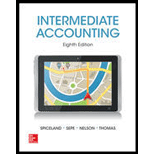
How is periodic interest determined for outstanding liabilities? For outstanding receivables? How does the approach compare from one form of debt instrument (say bonds payable) to another (say notes payable)?
Bonds
Bonds are a kind of interest bearing notes payable, usually issued by companies, universities and governmental organizations. It is a debt instrument used for the purpose of raising fund of the corporations or governmental agencies. If selling price of the bond is equal to its face value, it is called as par on bond. If selling price of the bond is lesser than the face value, it is known as discount on bond. If selling price of the bond is greater than the face value, it is known as premium on bond.
To find out: The periodic interest payments determined by the outstanding liabilities and outstanding receivables and also find out the approach compare from one form of debt (Bonds payable to another form (notes payable).
Explanation of Solution
The periodic interest payments determined by the outstanding liabilities
The periodic interest payment is determined for the outstanding liabilities are calculated by multiplying the debt outstanding amount during the period with effective interest rate.
The periodic interest payments determined by the outstanding receivables.
The periodic interest payments are determined for outstanding receivables are calculated by multiplying the debt outstanding amount during the period with effective interest rate.
The approach compare from one form of debt (Bonds payable to another form (notes payable).
The approach compares the particular form of the debt is whether, in the form of notes payable, bonds payable, pensions or other debt instruments
Want to see more full solutions like this?
Chapter 14 Solutions
INTERMEDIATE ACCOUNTING
- I am searching for the accurate solution to this general accounting problem with the right approach.arrow_forwardCan you explain the correct approach to solve this general accounting question?arrow_forwardCan you solve this general accounting problem using appropriate accounting principles?arrow_forward
- I need help solving this general accounting question with the proper methodology.arrow_forwardPlease provide the accurate answer to this general accounting problem using valid techniques.arrow_forwardPlease help me solve this general accounting problem with the correct financial process.arrow_forward
- Goodwill is an example of an indefinite-life intangible asset, meaning that public companies must test it for impairment rather than regularly amortizing to systematically reduce its value on the balance sheet of the public company. Can anyone recap the difference between limited-life versus indefinite-life intangible assets? Any specific examples of either category?arrow_forwardWhy are adjusting journal entries necessary at the end of an accounting period? Need hearrow_forwardWhy are adjusting journal entries necessary at the end of an accounting period?i need helparrow_forward
 Intermediate Accounting: Reporting And AnalysisAccountingISBN:9781337788281Author:James M. Wahlen, Jefferson P. Jones, Donald PagachPublisher:Cengage Learning
Intermediate Accounting: Reporting And AnalysisAccountingISBN:9781337788281Author:James M. Wahlen, Jefferson P. Jones, Donald PagachPublisher:Cengage Learning College Accounting (Book Only): A Career ApproachAccountingISBN:9781337280570Author:Scott, Cathy J.Publisher:South-Western College Pub
College Accounting (Book Only): A Career ApproachAccountingISBN:9781337280570Author:Scott, Cathy J.Publisher:South-Western College Pub Cornerstones of Financial AccountingAccountingISBN:9781337690881Author:Jay Rich, Jeff JonesPublisher:Cengage Learning
Cornerstones of Financial AccountingAccountingISBN:9781337690881Author:Jay Rich, Jeff JonesPublisher:Cengage Learning College Accounting, Chapters 1-27AccountingISBN:9781337794756Author:HEINTZ, James A.Publisher:Cengage Learning,
College Accounting, Chapters 1-27AccountingISBN:9781337794756Author:HEINTZ, James A.Publisher:Cengage Learning, EBK CONTEMPORARY FINANCIAL MANAGEMENTFinanceISBN:9781337514835Author:MOYERPublisher:CENGAGE LEARNING - CONSIGNMENT
EBK CONTEMPORARY FINANCIAL MANAGEMENTFinanceISBN:9781337514835Author:MOYERPublisher:CENGAGE LEARNING - CONSIGNMENT





